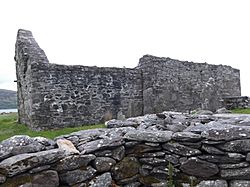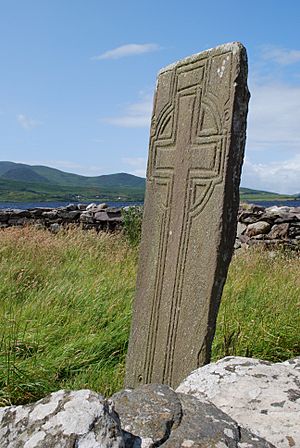Church Island (Lough Currane) facts for kids
| Oileán an Teampaill | |
 |
|
| Monastery information | |
|---|---|
| Established | 6th century AD |
| Diocese | Kerry |
| People | |
| Founder(s) | Fionán Cam |
| Architecture | |
| Status | ruined |
| Style | Romanesque |
| Site | |
| Location | Lough Currane, County Kerry |
| Coordinates | 51°50′06″N 10°07′45″W / 51.834893°N 10.129270°W |
| Public access | yes |
| Official name | Church Island (Lough Currane) Early Medieval Ecclesiastical Site |
| Reference no. | 60 |
Church Island is an ancient Christian monastery and a National Monument located on an island in Lough Currane, Ireland. It's a special place where monks lived and worshipped many centuries ago. Today, you can still see the remains of their old buildings.
Where is Church Island?
Church Island is found on a small island in Lough Currane. This lake is in County Kerry, a beautiful part of Ireland. The island is about 1.8 hectares in size, which is roughly the size of two rugby fields. It's located about 2.8 kilometers (or 1.7 miles) east of a town called Waterville. People sometimes call it Inis Uasail, which means "Upper Island."
A Look Back in Time: History of Church Island
The monastery on Church Island was started a very long time ago, in the 6th century AD. This means it was founded over 1,400 years ago! It was established by a saint named Fionán Cam.
Originally, the church on the island was made of oak wood. This type of wooden church was called a dairthech. Later, around the 12th century, the wooden church was replaced. A new stone building was constructed in the Romanesque style. Romanesque buildings are known for their thick walls and round arches. Some parts of this old stone church are still standing today.
What You Can See on Church Island
When you visit Church Island, you can explore the remains of the old monastery. There is a stone church, which was the main place of worship. You can also see a clochán, which is a type of old stone hut, often shaped like a beehive. This particular clochán might have been a hospitium, a guesthouse where visitors or pilgrims could stay.
Besides these, there are two other small stone rooms, or "cells," where monks likely lived. The site also has three altars, which are special tables used for religious ceremonies. You'll find 11 cross slabs, which are stones with crosses carved into them. There are also pillar stones, which are tall, upright stones.
Inside the church, there's a cool relief carving. It shows a musician playing a lyre, an ancient stringed instrument. This carving gives us a peek into the art and culture of the people who lived here long ago.



